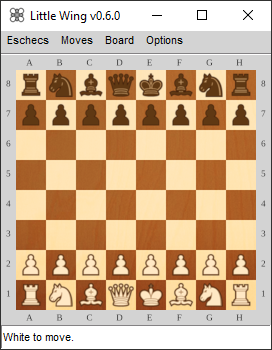Eschecs is a chess playing program, using the UCI protocol to dialog with a chess engine.
To move a piece, drag it with the mouse to the target square.
A default chess engine is loaded at application start.
You can select another opponent in a list of chess engines. See the "Moves" menu.
The default play mode is user versus computer, user playing white.
If you wish the computer to play white, click on "Computer move".
To play in human versus human mode, uncheck the "Autoplay" option in the "Moves" menu.
↑ Go to the last position
↓ Go back to the first position
← Go back to the previous position
→ Go to the next position
ESC Close the application
To install a new engine, you have to edit eschecs.eng. That file stands in the config directory.
Eschecs uses the UCI protocol.
For the "go" command, Eschecs uses the following syntax:
go movetime 1000
You can change the value of the parameter by editing eschecs.ini, which stands in the config directory.
Eschecs is an open source program for the Free Pascal Compiler.
Eschecs uses fpGUI, BGRABitmap and uos libraries.
There are three methods to compile Eschecs.
You can use the script build.cmd (for Windows) or build.sh (for Linux). Free Pascal must be installed on your system.
You can use the Lazarus project files eschecs.lpi and options.lpi. There are, indeed, two applications to compile.
You can also use the MSEide project files eschecs.prj and options.prj.
Once the application is compiled, you need to download the binaries of the uos library, and install them in the audio directory, so that if you OS is (for example) Windows 64, the uos binaries will be in \audio\lib\Windows\64bit directory.
You can download uos library binaries here.
Finally, you need one or several UCI engines. To install your engines, you need to edit with your favourite text editor the file eschecs.eng in the config directory. Of course, in the release packages, some engines are already included and installed.
The wood chessboard and its pieces are the work of Daniela Di Lena.
The application icon is the white king of the Chess Montreal font. Chess Montreal is a TrueType font by Gary Katch.
Chess Alpha is a TrueType font by Eric Bentzen. Chess Condal, Chess Line, Chess Lucena, Chess Magnetic, Chess Mark are TrueType fonts by Armando Hernandez Marroquin.
Sound effects come from Lichess, the well-known chess server by Thibault Duplessis, or from The Essential Retro Video Game Sound Effects Collection by Juhani Junkala.
Fruit 2.1 is a chess program by Fabien Letouzey. Moustique is a UCI engine by Roland Chastain, based on Schachspiel by Jürgen Schlottke.
See this page for details about other engines shipped with Eschecs.
fpGUI is a cross-platform GUI toolkit using Free Pascal, by Graeme Geldenhuys.
BGRABitmap is a graphics library by Johann Elsass.
uos is a collection of audio libraries with united procedures by Fred van Stappen.
Thanks to John Bennett and to Norbert Raimund Leisner for the Moustique logo, a picture of the Farman F455 Moustique. Thanks to Johann Elsass for his graphical snippets. Thank to Fred van Stappen, for his valuable contribution concerning Unix compatibility, sound, bug fixes, and kind support.
Thanks to the translators: Martin Sedlak (Czech), Jean-Luc Gofflot (Dutch), Marcello Basso (Italian), Ñuño Martínez (Spanish). The German version was made by several members of the German speaking Lazarus forum.
Eschecs is a Pascal program by Roland Chastain, with contributions by Johann Elsass and Fred van Stappen.
